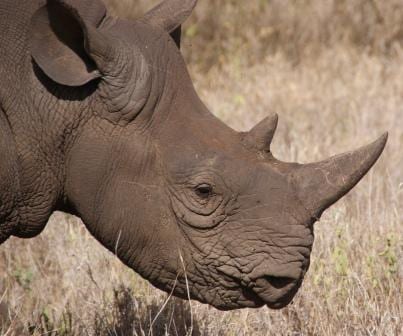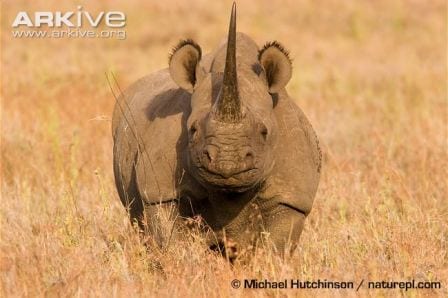Black rhino hunting permit- Why are conservationists supporting it?
By Emma-Louise Nicholls, on 17 January 2014
 Last Saturday, 11th January 2014, a permit to hunt a black rhino for sport was sold at a US auction for $350,000. Much of the general public was horrified, and the auction house and associated hunting club subsequently received letters and emails of protest ranging from polite through abusive, to actual death threats.
Last Saturday, 11th January 2014, a permit to hunt a black rhino for sport was sold at a US auction for $350,000. Much of the general public was horrified, and the auction house and associated hunting club subsequently received letters and emails of protest ranging from polite through abusive, to actual death threats.
I for one simply can not understand the mindset of someone who would want to kill such a magnificent animal, and for sport, and that makes it hard for me to see the idea as anything but barbaric. However, is there more to it? Is it really a topic with many more branches to be considered in order for an informed and level-headed decision to be made? The permit was to hunt a black rhino (Diceros bicornis), a species listed as endangered and with only around 5000 individuals left in the wild. It would seem on the surface, a terrible thing to do, and yet many conservationists and specialists believe it to not only be acceptable, but that it will in fact help rhino populations.
 A deeper look at the facts
A deeper look at the facts
It has long been debated whether hunting can be used as a conservation tool, in the same way permits are sold to visit mountain gorillas in the wild. Neither is good for the specific individual animals involved (though of course the gorillas tend to have a rather higher chance of surviving the ordeal), but it results in making the species as a whole, be it gorillas or rhinos, more valuable to the local community, which in turn provides an incentive to protect them. Hunting rhinos and visiting mountain gorillas are opposite ends of this scale but just perhaps, the principle is the same. In 2005, Richard Emslie from the IUCN SSC African Rhino Specialist Group (1), wrote:
Those whose primary focus is on the welfare of individual animals targeted for hunting, as opposed to the broader issues of how best to conserve viable populations of species and their related habitats, tend to be against hunting, irrespective of whether it can be demonstrated to be sustainable and / or create positive incentives to encourage people in developing countries to conserve wildlife.
Emotions
I would argue that a lot, if not all people who do charity work voluntarily or otherwise, will have some level of emotional reason. It could be their life has been touched by cancer in some way and so they run a marathon for Macmillan, or they have a particular fondness for an animal or species and raise money for a relevant animal charity. Whatever the reason, humans are emotional beings but whilst the idea of a rhino being hunted simply horrifies me, is it the wrong thing for me to do for the future of the species, to not be able to look past that emotive response?
 Taking the black rhino hunting permit as a case study, it is worth noting that both Namibia and South Africa both release five permits every year (2) to hunt a black rhino. This is nothing new. It is also worth noting however that the hunter isn’t given free range, they are allocated a specific individual, classed as ‘surplus’. Individuals classified as surplus are male rhinos, past breeding age, in a population where males outnumber the females. The idea of surplus black rhino has been recognised by conservationists as far back as 1992 and they have been shown to actually have a negative impact on rhino populations as a whole (3). It sounds counterintuitive but makes sense when you look at the facts. For a number of reasons that I don’t have the space to go into, but are worth looking up for yourself, there is often a bias towards males in a wild rhino population (4). It was demonstrated by a case study in Pilanesberg National Park (2), that this surplus leads to more fighting between males resulting in a higher mortality rate, and worse, females and calves often fall victim in the fighting as well. Furthermore, preliminary studies by the SADC Rhino Management Group (1) indicated that rhino reproductive rates are higher in populations with a lower male to female ratio, possibly due to a lower stress on food resources. Various solutions to this issue have been suggested and/or tried, but with little success (2).
Taking the black rhino hunting permit as a case study, it is worth noting that both Namibia and South Africa both release five permits every year (2) to hunt a black rhino. This is nothing new. It is also worth noting however that the hunter isn’t given free range, they are allocated a specific individual, classed as ‘surplus’. Individuals classified as surplus are male rhinos, past breeding age, in a population where males outnumber the females. The idea of surplus black rhino has been recognised by conservationists as far back as 1992 and they have been shown to actually have a negative impact on rhino populations as a whole (3). It sounds counterintuitive but makes sense when you look at the facts. For a number of reasons that I don’t have the space to go into, but are worth looking up for yourself, there is often a bias towards males in a wild rhino population (4). It was demonstrated by a case study in Pilanesberg National Park (2), that this surplus leads to more fighting between males resulting in a higher mortality rate, and worse, females and calves often fall victim in the fighting as well. Furthermore, preliminary studies by the SADC Rhino Management Group (1) indicated that rhino reproductive rates are higher in populations with a lower male to female ratio, possibly due to a lower stress on food resources. Various solutions to this issue have been suggested and/or tried, but with little success (2).
 Further considerations
Further considerations
Let me now add two extra pieces of ingredient to the controversial mix. Firstly, the $350,000 paid for the hunting permit last Saturday, is going to rhino conservation. The auction house waved their fees so that 100% of this money will go to conservation. That’s $350,000 that can be used to protect the wild rhino populations that have been (it seems) left more viable as a result of the hunting. Secondly, the wild white rhino (Ceratotherium simum) population was at just fifty in the early part of the last century. Through conservation efforts white rhinos have come back in force and their population now stands at over 20,000 (5). Part of the conservation techniques implemented that resulted in this comeback was the use of hunting permits (5). It simply turned rhinos in to a valuable commodity worth protecting, for local land owners.
Given all of the facts (and I encourage you to read further on the matter for yourself) my personal conclusion is:
I really don’t like it. But, given all the facts, I have to agree with it.
Emma-Louise Nicholls is the Curatorial Assistant at the Grant Museum of Zoology
Suggested further reading:
Save the Rhino
Species Survival Commission
African Rhino Specialist Group
International Rhino Foundation
ARKive
References
1. IUCN SSC African Rhino Specialist Group
2. http://www.savetherhino.org/rhino_info/thorny_issues/trophy_hunting
3. Leader-Williams, N. et al. (2005). Trophy hunting of black rhino Diceros bicornis: Proposals to sustainability. Journal of International Wildlife Law and Policy. Vol. 8, Is. 1
4. Garnier, J. N. et al. (2001). Mating system and reproductive skew in the black rhinoceros. Molecular Ecology. Vol. 10, Is. 8. p.2031-2041
5. http://www.savetherhino.org/rhino_info/thorny_issues/poaching_crisis_in_south_africa
.
6 Responses to “Black rhino hunting permit- Why are conservationists supporting it?”
- 1
-
3
Edmund Connolly wrote on 20 January 2014:

Surely a problem with the license going to auction is that you do not know the person buying it is skilled, unless there is some sort of prerequisite required to make on eligible to bid for such an item? (I have no idea about this).
A bit closer to home is the marginally less problematic issue of fox hunting, because there is such a gaping loophole in the Hunting Act, saying it has to be intentional thus easily navigated. Perhaps, if hunting licenses like the above were brought in more generally for sportsmanship as well as culling one could generate revenue from the affair.
-
5
Richard Kelly wrote on 31 January 2014:
It is very easy to have a knee-jerk reaction to hearing of the hunting of an endangered animal. As you quite rightly pointed out though this reaction should always be tempered with the facts of the matter. The fate of a species is not laid on the shoulders of any one individual and if their death can bring about a healthier population (and extra money to get them there) then I agree that hunting licences should be used in this way. I might add though that this needs to be tightly regulated and all steps recorded and transparent to make sure the claims of the licencor are adhered to.
-
6
Cecil the Lion, Cory the Cod, Monty the Monkfish | Fistful Of Cinctans wrote on 6 August 2015:

[…] It’ll be cycled out of the news soon. At the time of writing, some news desks are still shuffling out copy, like the above statue article, but momentum is waning and no doubt there’s a big news story round the corner that will literally make this yesterday’s news. When the moral outrage slowly shuffles off the bottom of Twitter feeds, hunters can go back to legally and illegally hunting various species around the world and we can safely buy the non-organic chicken breasts the next time Sainsbury’s runs out of the organic stuff with the tiniest of guilt pangs. Of course, there’s ever so slim a chance that this incident could do for lions what the whale conservation movement so successfully achieved for cetaceans but that was a decades long movement not a flash in the pan thing. Don’t believe me? Various flavours of rhinos have been shuffling off the face of the planet for the last 50 years or so with this century being a particularly depressing one for some of them and they’re still being legally hunted. […]
 Close
Close


I am neither a hunter, nor a friend of Big Game Hunting. But I learned that wildlife management – even the management of rhinos – unfortunately cannot be done without culling of specific animals for conservation reasons (there is a lot of literature on this). So, if an animal has to be killed for a good reason anyway, why not get money for it from a skilled marksman (regardless of his embarrassing motives) – provided that the money goes into conservation and rhino protection. However, in rhino populations, where culling is not mandatory, the authorizing of hunting licenses should be prohibited.- Really disgusting are those so called animal rights activists, who allegedly want to protect the lives of rhinos, while threatening to kill a rhino hunter (no matter, how you feel about these shooters).